Official post from For Entrepreneurs
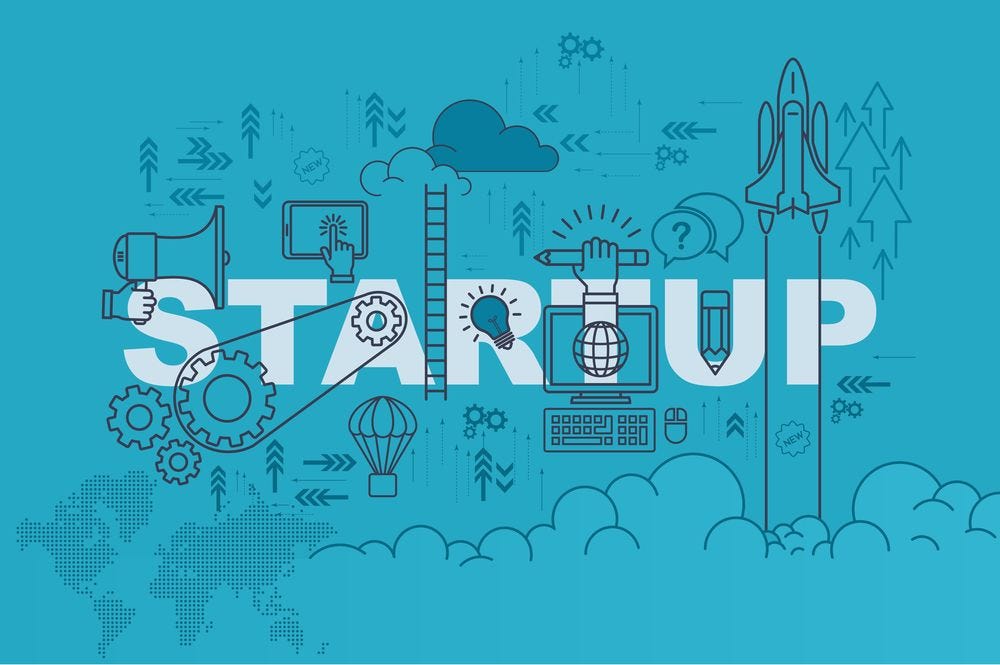
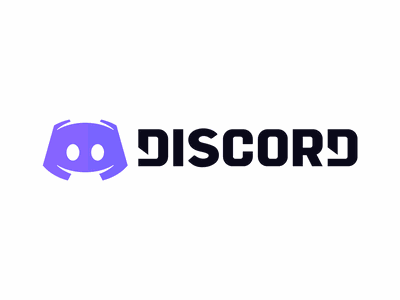
Join our discord server for more intellect discussions “Big Brains”.
Follow my blog “Big Brains”, if you like the content I post.
Because of the huge overload of topics clamoring for a startup CEO’s attention, it can be really hard to figure out where to focus. As anyone involved with startups will tell you, focus is key to success. I believe there is one question that should dominate startup founders’ thinking, as it brings all aspects of the startup into alignment, and shows what they need to accomplish to ensure success/survival. That question is:
When do we run out of money, and are we on track to reach the milestones needed for a successful financing before then?
Fortunately the milestones needed for a successful financing are 100% aligned with the milestones needed to build a successful company.
Focus is crucial. This one question produces focus, and alignment across all departments. And if answered correctly, it ensures that your startup will survive by not running out of cash. If there is any initiative in the company that doesn’t align with answering this question positively, it very likely shouldn’t belong on the agenda.
This question then leads to a series of other questions, that make it clear what the company has to do, first to survive, and secondly to be successful. Those questions might look like this:
- What are the milestones needed for a successful fund raise? (see below)
- What are the most important risks in our plan to reach the milestones? What can we do to mitigate those risks?
- If we are not on track to reach those milestones with the cash available, what can we do to fix that?
Milestones needed for a successful fundraise
Let’s start by looking at the first question: “what are the milestones needed for a successful fundraise?”. I think most entrepreneurs understand that valuation does not simply increase because you have been working hard for many months since your last fund raise. As many have found out, it can easily decrease if you haven’t made the progress that your investors were hoping for. One goal of this article is to help entrepreneurs understand the specific milestones they need to achieve for a successful fund raise at a higher valuation. (BTW — even if you are cash flow positive and don’t need to raise capital, these milestones are still the right milestones to use to run your business in an optimal way.)
I believe the easiest way to understand these milestones is to look at a startup as having three key phases. See the diagram below. Even though many investors won’t use these same words, these are the milestones that they are using as their way of judging how far a startup is along the journey from highly risky concept phase, to a largely de-risked, growth stage.
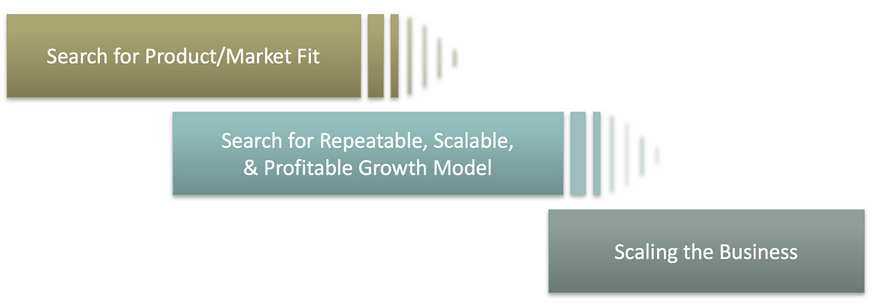
Fig 1. The Three Phases of a Startup
As the business moves through these stages from left to right, risk is removed, and the venture becomes more and more attractive to investors, and will receive a higher valuation.
If one were to simply look at the numbers of a startup, here is how risk would be perceived. (This is how growth stage investors look at the world.)
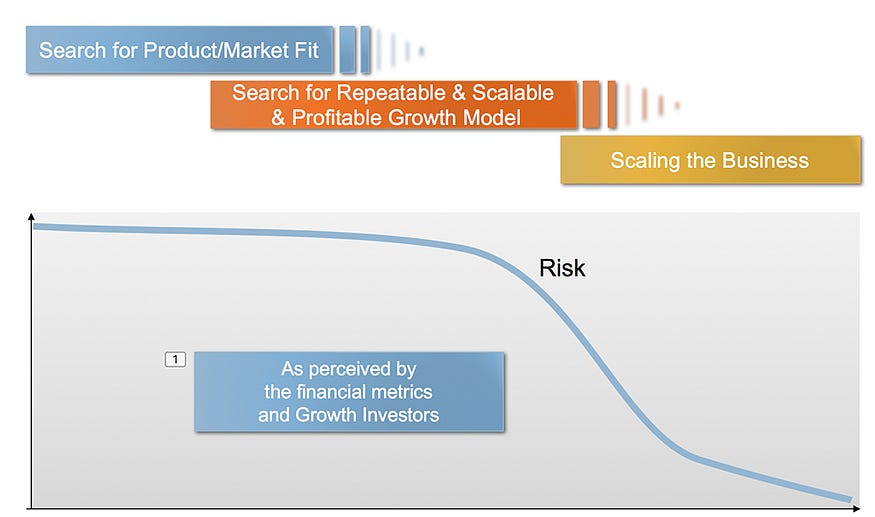
However early stage investors have a different way of evaluating startups and are able to interpret signals that don’t yet show up in predictable financial metrics. So their view of risk versus startup phase, might look more like this:
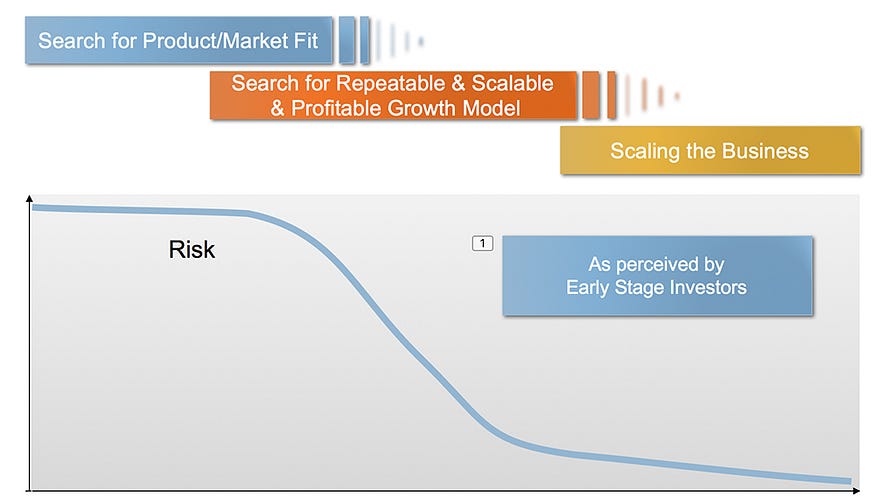
And as you might expect, startup valuations are inversely correlated with risk:
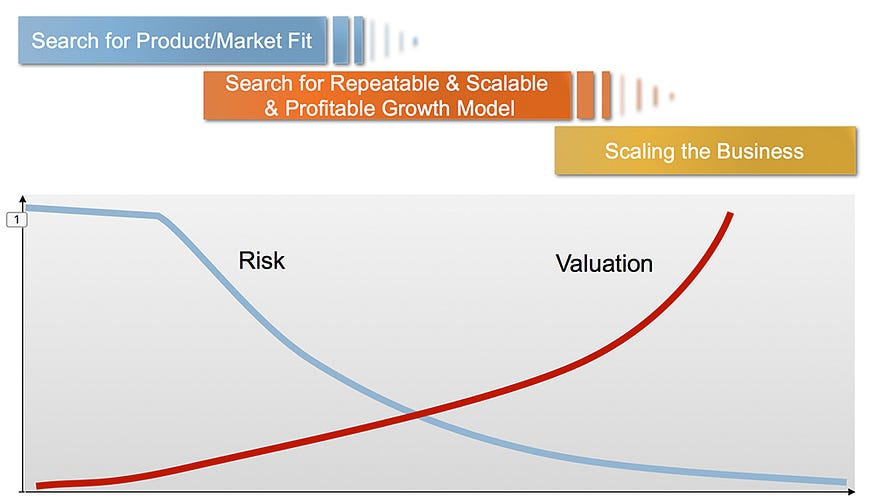
So the key to a successful fund raise in the early days is showing progress through these phases.
Below shows roughly how today’s financing rounds correlate with the these different phases:
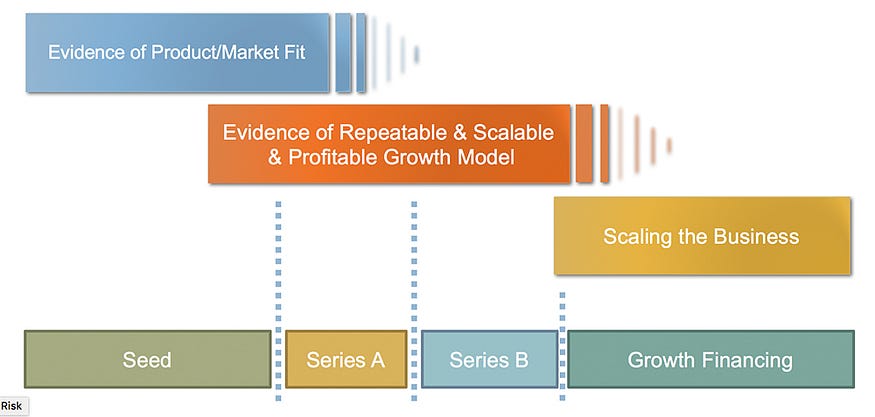
Let’s look at what it takes to meet the milestones that investors will look at as a startup moves through these phases.
Search for Product/Market Fit
Executing through the first phase, Search for Product/Market Fit, is very well understood, and authors like Eric Ries and Steve Blank have done a great job of documenting how to navigate this phase. However there is still confusion about what product/market fit actually looks like. Most of the early articles about product/market fit did not break out the second phase of building a repeatable, scalable, and profitable growth model, and merged these two phases into one. I believe it is really helpful to separate them, as the work you have to do in each phase is very different.
Once separated, it makes it much easier to explain what milestones are involved in each phase. I would suggest that the following list is a good starting point for what investors will be looking for to demonstrate that you have established early product/market fit. I’d like to invite other investors/founders who read this to add their views on this topic in the comments:
- Some number of customers that have paid money to purchase your product. (The actual number will depend on the price paid. If your product sells at a low price point, then investors will likely be looking for a larger number. If you have a high-priced product with a longer sales cycle, then they will usually settle for a smaller number. I would suggest at least 10 customers for a mid-priced product in the $10k to $100k ARR range, and more as the price gets lower. Think of 10 customers as a bare minimum, and recognize that the more you have, the more clearly you have proven product/market fit.
- The majority of those customers have been successfully onboarded, and are happy users of the product. They are realizing the promised business benefits.
- Your customer churn rate is low, and ideally you can show how you can get to Net Negative Churn from expansion in the customers that stay with you. (For more on this topic see Unlocking the Path to Negative Churn.)
- Their usage should ideally be increasing over time, but if not be at least flat. It does not look good if your customer usage is dropping over time.
- A significant number should be willing to get on the phone with investors and describe the pain they were trying to address, and confirm that your product solved that pain, and is working well for them. Ideally they should be talking about expanding their use of the product going forward. If they evaluated your primary competitors and can talk about why your product was better than those, then that call will be significantly more powerful.
- The customers should have the same (or very similar) use case. (Unless you have a developer platform, it is not clear that you have product/market fit if you have sold a product to solve very different problems into very different customer types, as those are different markets.)
- If the customers are all clustered in a single vertical or market segment, that market segment should be large enough that an investor can see a decent sized business (say >$50m in annual revenues) coming from just that same segment, and easily see how you can jump from that segment to other segments without having to develop a different product, or very different go-to-market mechanism.
- If you have a two-sided market place, your problem is twice as hard, as you have to prove that your product works for both sides of the marketplace.
Let me stress that the above list is my personal recommendation for how to think about product/market fit, and should not be seen as a set of hard requirements. If you haven’t achieved the milestones listed above, you may still be able to raise money. But it is likely to be still viewed as a Seed stage deal. Where things don’t look so good is if you have already raised a decent sized seed round with the investors expecting to see product/market fit at the end, and failed to reach these milestones.
Search for a Repeatable, Scalable, & Profitable Growth Model
The second phase, Search for a Repeatable, Scalable, & Profitable Growth Model, is a less well understood. And given that most founders come from a product or engineering background, it can often be a hard phase for them to navigate. Let’s look at each key word here separately.
Growth Model
The term growth model covers the process of acquiring customers, and then onboarding them and turning them into happy users who keep using the product, and are seeing the business benefit that your sales pitch promises. So it goes beyond sales and marketing, and includes customer success and expansion revenue.
Repeatable
When thinking about repeatable, it helps to think about both predictable and repeatable: you are looking to make sure that the way you acquire and onboard new customers, and get them to expand is both predictable and repeatable.
If you have a touchless sale that doesn’t use salespeople, your life is a lot easier. Your growth process is repeatable if you have found a funnel process that predictably repeats over time. E.g. you have found a particular way to drive visitors to your website such as Google Adwords that can be repeated, a percentage of visitors convert into trials, and a percentage of trials convert into closed deals.
When your growth process includes sales people, things become a more complicated. To show that your growth process is repeatable, you will need to show that several salespeople have been successfully hired and onboarded, with a predictable ramp time and quota achievement level. You are looking to demonstrate to your future potential investor that adding salespeople will have a predictable and repeatable impact on bookings. As anyone who has built an initial sales organization knows, this is much harder to achieve in practice than it sounds. The issue is that the early sales can often be driven by highly talented and credible founders, and perhaps a single superstar early salesperson. But when you start trying to hire more reps, the talent level drops, and the playbook may not work half as well. A key factor for success here is building a really great on-boarding and training process for new sales hires. This is often overlooked by founders from a technical or product background, as they assume that everyone will simply get why their product is so great, and overlook the need to train people on how to sell it. My advice here: as you enter this phase, founders should look to invest significant amounts of their own time in creating a great onboarding course for new sales hires. These are some of the most expensive hires you will make, and the company success is heavily dependent on their ability to succeed. As founders you will know your customer, market, competition, sales process, messaging, etc. in detail, and you’re often the best people around to help develop big pieces of this onboarding training course.
Here is a chart that I find extremely helpful as a board member looking at this topic:
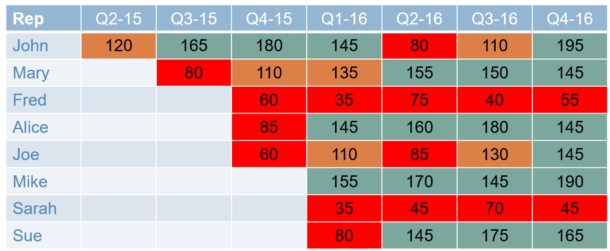
We’re looking for lots of Green reps in the final columns, which we see in the Q4–16 column above.
As mentioned earlier, don’t stop at sales. You also need to ensure that you can successfully onboard the customers and turn them into happy customers that will likely expand at some point in the future. So similar attention needs to be paid to Customer Success and churn.
Scalable
Once you have found a process that can repeat predictably, you now face a second challenge: how to make that scalable. This is hard as most of the lead sources out there won’t scale infinitely. For example if you are using Google Adwords, there is a limit to how many people are searching using the term you have found to work. And often other lead sources can be a lot less effective, or a more expensive. So one challenge you have to solve is how to successfully spin up more than one lead source. An ideal source to get working is Inbound Marketing (usually this is done with content, but sometimes with a freemium product, or similar.). The problem with inbound marketing is that it usually starts slow, and builds over time. But once the engine gets going, it can be one of the most powerful lead sources as it can scale without significant limits, and is typically very cost effective.
If you have a sales force, one area that I have seen trip up most companies is a failure to show that they can hire new sales people on time. Doing this repeatably requires spinning up a strong internal recruiting process, and many times this important startup skill is ignored until it is too late. (I have written more on this topic here: A shockingly common way that sales misses plan and here: Recruiting — the third crucial startup skill.)
For me the key proof point of whether you have found a repeatable and scalable growth process is a chart showing bookings (which in a SaaS business means Net New ARR = New + Expansion — Churned ARR) that is consistently increasing quarter over quarter. Most startups prefer to show off their growth using an ARR graph. But because ARR will keep growing even if you have flat bookings, that doesn’t tell you the key measure of success, which is the ability to keep growing the New ARR coming from new customers and expansion of existing customers, while not losing too much to churn.

Profitable
To have a profitable growth process, you will need to demonstrate that your LTV is greater than your CAC (my personal guideline is that it should be 3x greater), and that you have a fast payback time on your CAC (18 months or less is ideal). If it is not immediately clear what I am talking about, may I refer you to this blog post that explains these terms and guidelines in great detail: SaaS Metrics 2.0 — A guide to measuring and improving what matters.
In calculating LTV, it is very important that you look at Gross Margin, and not just revenue. In a SaaS business, any Customer Success people that are needed to onboard and support the customer should be included in the cost of goods sold, and will therefore directly impact gross margins. So this will require a very cost effective Customer Success team.
The Growth Phase
Once your growth process becomes repeatable, scalable, and profitable, you now have the magic formula that growth investors are looking for: a business where you can simply add money to Sales, Marketing and Customer Success to increase growth and you will get back a multiple on your money. A business that has proven these three elements is considered by investors to be massively derisked, and will earn a much higher valuation than an earlier stage startup.
The Series B round — a ‘tweener
A common way to think about these phases is that the seed round should get startups to good early signs of product/market fit, and that is what help them close a Series A. Even better if they have demonstrated some early signs of a repeatable, scalable and profitable growth process, as that will make raising a Series A round a lot easier, and increase valuation.
For the Series B round, investors are expecting to see a lot more progress on the repeatable, scalable and profitable growth process. However as I defined it above, it’s probably unlikely that you will have fully proven out all of these elements. So you have some leeway here. But recognize that the further you are able to get, the higher the valuation you can expect to see.
What are the most important risks in our plan to reach the milestones?
This is a great follow on question, together with “What can we do to mitigate those risks?” Once the seriousness of realizing how fast your money will run out, and how little time you have before you need to be out fundraising sinks in (allowing three months for fundraising), you may realize that you have some big risks. Here are some good secondary questions:
- Should we tighten our focus? The answer to this is frequently yes — this is one of the most effective ways of getting more done. Look for ways to cut out activities, initiatives and particularly work for customers that aren’t a perfect fit for your business.
- Should we cut out some of the less important product features?
- Should we lower our burn rate to extend our runway?
- The longer the runway, the higher our chances are to reach the milestone. Given that it is not predictable how long it will take for us to find product/market fit, or a repeatable/scalable sales process, it is my personal recommendation that you keep burn as low as possible while in the first two phases, and then throw the switch hard over to the “invest aggressively” position as soon as you have found a repeatable, scalable and profitable sales process and have the cash to finance that.
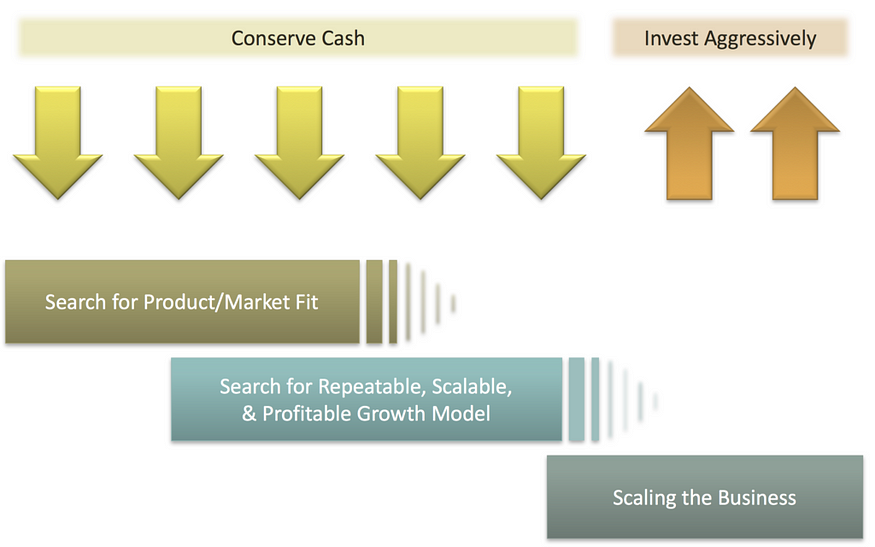
If we are not on plan to hit our milestones, what can we do?
- Are there any options to extend our runway?
- Do we need layoffs to lower our burn rate?
- Can we raise venture debt to give us a few extra months?
- Should we raise an interim smaller round, perhaps an extension of our last round?
- And as a last resort, should we be looking to sell the company before we run out of cash?
Conclusion
This post was designed to highlight the one question that I think should drive startup focus in the early days. Even though it might seem like this question is overly focused on what is needed to get a successful financing, it is my opinion that these are the same steps you would want to follow even if you were profitable and never needed to raise another dollar.
Not surprisingly, this is a key topic for me at every board meeting, starting with a line graph that shows the cash balance dropping over time, and the point where it hits zero. Once you realize how little time you have and how much you have to achieve, it will usually lead to some highly productive discussions on the important topics, and stop you from wasting time on things that aren’t worthy of your time and attention.







